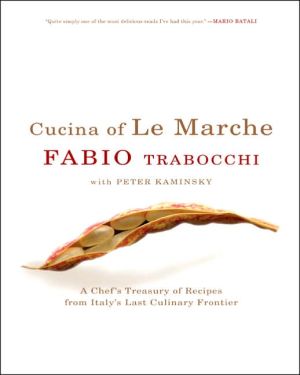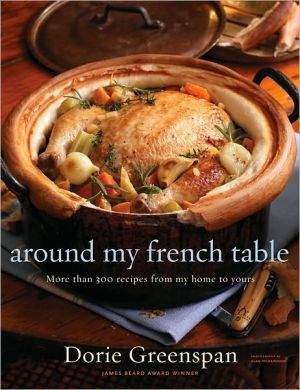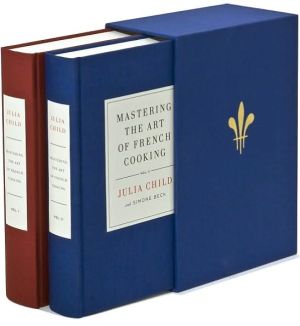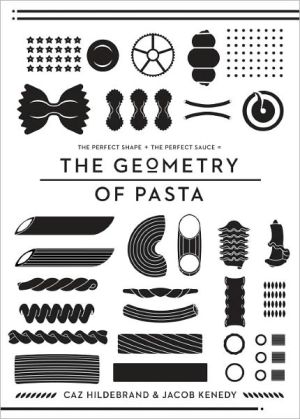Cucina of le Marche: A Chef's Treasury of Recipes from Italy's Last Culinary Frontier
Named a Best New Chef in America by Food & Wine and Best Chef: Mid-Atlantic by the James Beard Foundation, rising star Fabio Trabocchi offers a unique take on his native cuisine, that of the until-now-overlooked Le Marche region of Italy.\ Every chef is a product of a place and a tradition. Fabio Trabocchi's soul is in the Italian province of Le Marche. Equidistant from Rome and Florence, Le Marche is on the Adriatic coast, bordered to the north by Emilia-Romagna, to the west by Tuscany...
Search in google:
Named a Best New Chef in America by Food & Wine and Best Chef: Mid-Atlantic by the James Beard Foundation, rising star Fabio Trabocchi offers a unique take on his native cuisine, that of the until-now-overlooked Le Marche region of Italy. Every chef is a product of a place and a tradition. Fabio Trabocchi's soul is in the Italian province of Le Marche. Equidistant from Rome and Florence, Le Marche is on the Adriatic coast, bordered to the north by Emilia-Romagna, to the west by Tuscany and Umbria, and to the south by Lazio and Abruzzo. This geography accounts for the rich variety of Le Marche's food traditions. The first chefs of Le Marche assimilated recipes, ingredients, and techniques from visiting mariners from Greece and North Africa. In his debut cookbook, Trabocchi showcases his signature style of cooking—called "soulful and passionate—not pretentious" by Food & Wine—combining traditional elements of Italian cuisine with a contemporary European sensibility that draws on the many flavors he's experienced throughout his extensive travels and techniques honed at restaurants around the world. Publishers Weekly Trabocchi, chef at Maestro in Washington, D.C., is a native son of Le Marche, the Italian region that the New York Times recently deemed "the new Tuscany." Trabocchi grew up in the small town of Santo Stefano, and with assistance from Kaminsky (Pig Perfect) he achieves a lovely style that is rather low-key in comparison to the commanding tone many chefs affect in cookbooks. Trabocchi also does an excellent job of isolating the best, most characteristic recipes from Le Marche, as cucina marchigiana is often difficult to differentiate from that of Umbria or Emilia-Romagna. Yet what makes the food of Le Marche so special is its rustic quality, which is hard to imitate in American kitchens. It's fun to read about dishes like Roasted Suckling Pig Ascolana-Style and Turbot in Smoky Hay, but preparing them may be out of reach ("You will need to get clean green hay from a local farm," instructs the latter recipe). Fried Stuffed Olives Ascolana-Style, one of the region's classics, calls for pitting, stuffing (with a mixture of chicken liver and pork butt) and deep-frying 60 individual olives. There are less labor-intensive choices, such as Ancona's famous fish stew, and Trabocchi includes an excellent discussion of local wines. (Oct.) Copyright 2006 Reed Business Information.
Cucina of Le Marche\ A Chef's Treasury of Recipes from Italy's Last Culinary Frontier \ \ By Fabio Trabocchi \ HarperCollins Publishers, Inc.\ Copyright © 2006 Fabio Trabocchi\ All right reserved.\ ISBN: 0060741627 \ \ \ Bucatini with Guanciale\ Bucatini al Guanciale\ Serves 6\ When I was a boy, this simple dish was a favorite for lunch at our apartment at number 12 Via Guazzatore. But as recently as a few years ago, I probably would not have included the recipe in a cookbook for use in America, because guanciale, cured hog jowls, were unlikely to be available to home cooks. Now, though, you can buy guanciale in many shops that sell gourmet products, as well as in Italian specialty markets.\ Anyone who has attended a pig roast in the American South knows that the cheek is one of the prized parts. Because it is a muscle that gets so much exercise, the meat is rich and succulent. I usually keep some guanciale or pancetta in the refrigerator, ready to fix a quick sauce, to lend robust flavor to beans, to enrich stews. If necessary, you can substitute pancetta for the guanciale here.\ Ingredients:\ \ ½ pound guanciale (see Sources, page 223) or pancetta\ 1 pound bucatini\ 1 cup freshly grated Parmigiano-Reggiano (about 4 ounces)\ ½ cup grated pecorino\ Kosher salt and freshly ground\ black pepper\ \ Instructions:\ Bring a large pot of salted water to a rolling boil.\ Meanwhile, remove any herbsand spices from the surface of the guanciale and trim away any dry spots. Cut into medium-fine dice. (Or, if using pancetta, cut it into medium-fine dice.) Put the guanciale (or pancetta) in a large sauté pan, place the pan over medium-high heat, and slowly render the fat from the meat. When the guanciale begins to crisp, after 3 to 4 minutes, remove the pan from the heat and set aside.\ Add the bucatini to the boiling water and cook until al dente, 8 to 10 minutes.\ Meanwhile, return the pan with the guanciale to the stovetop and slowly warm over medium-low heat.\ Drain the pasta, reserving about ¼ cup of the cooking liquid. Add the pasta and grated cheese to the guanciale and shake the pan back and forth to combine the ingredients. Add just enough of the reserved pasta water--a few tablespoons should suffice--to create a sauce with a creamy consistency. Season with salt and pepper to taste and serve immediately in warm pasta bowls.\ \ Wine Must Polenta\ Polenta di Mosto\ Serves 6\ Once the grapes have been pressed for wine in the fall, what's left in the wine press is known as must. After the harvest, it was used in this dessert found all over Le Marche. It was often prepared as a thank-you for the workers in the vineyards. The sweetened polenta was mounded on large platters, sprinkled generously with walnuts, and served at the end of the harvest feast.\ You would be hard pressed to come up with a more powerfully flavored dessert than this.\ Note Wine must is only available during harvesttime. Ask your favorite winemaker or local vineyard if it is possible to purchase some.\ Ingredients:\ \ 1¼ cups granulated sugar, plus extra for sprinkling\ 1¾ cups white polenta flour (such as Moretti bramata bianca; see Sources, page 223) or finely ground yellow polenta\ 5 cups wine must\ 2 cups walnut halves\ \ Instructions:\ Combine the sugar and polenta in a medium bowl.\ Pour the must into a large saucepan. Bring to a simmer over medium-low heat and simmer until reduced by one-third, to about 3½ cups. Strain the must through a fine-mesh strainer into another large saucepan. Bring back to a simmer over medium-low heat. Whisking constantly, add the sugar and polenta in a slow, thin stream, then continue whisking for 1 minute. Simmer for 1 hour, stirring vigorously with a wooden spatula or spoon every 5 to 10 minutes to prevent lumps.\ Pour the warm polenta into a large serving dish. Sprinkle with sugar and the walnuts. The polenta can be served warm, at room temperature, or cold. (Cool to room temperature before refrigerating to serve cold.) Spoon out the warm polenta, or cut the cooled or chilled polenta into wedges or slices.\ \ \ Continues... \ \ \ \ Excerpted from Cucina of Le Marche by Fabio Trabocchi Copyright © 2006 by Fabio Trabocchi. Excerpted by permission.\ All rights reserved. No part of this excerpt may be reproduced or reprinted without permission in writing from the publisher.\ Excerpts are provided by Dial-A-Book Inc. solely for the personal use of visitors to this web site. \ \
\ Mario Batali"One of the most delicious reads I have had… makes me want to cook these regional specialties all year long."\ \ \ \ \ Daniel Boulud"Wonderful culmination of Trabocchi’s genius talent and the traditional heritage of Le Marche… beautiful collection of refined, yet classic dishes."\ \ \ Cesare Casella"From my first meal at Maestro, I have been a huge fan of Trabocchi’s… combines tradition and innovation."\ \ \ \ \ Michel Richard"A beautiful postcard from Le Marche. Thank you Fabio for sharing these wonderful treasures!"\ \ \ \ \ Hubert Keller"A rare innovator in Italian cuisine and pioneer… an amazing cookbook with terrific food, incredible flavors… a classic."\ \ \ \ \ Roberto Donna"I have always had a great admiration for Fabio’s cooking… ‘Bravo, Fabio,’ you make Italy proud!"\ \ \ \ \ Patrick O'Connell"Trabocchi invites us home… an accomplished and daring chef, he rewards us with unique and wonderfully approachable, treasured family recipes."\ \ \ \ \ Phyllis Richman"Move over, Tuscany. Italy’s Le Marche region is moving onstage Trabocchi has quickly become a star among Washington chefs."\ \ \ \ \ Publishers WeeklyTrabocchi, chef at Maestro in Washington, D.C., is a native son of Le Marche, the Italian region that the New York Times recently deemed "the new Tuscany." Trabocchi grew up in the small town of Santo Stefano, and with assistance from Kaminsky (Pig Perfect) he achieves a lovely style that is rather low-key in comparison to the commanding tone many chefs affect in cookbooks. Trabocchi also does an excellent job of isolating the best, most characteristic recipes from Le Marche, as cucina marchigiana is often difficult to differentiate from that of Umbria or Emilia-Romagna. Yet what makes the food of Le Marche so special is its rustic quality, which is hard to imitate in American kitchens. It's fun to read about dishes like Roasted Suckling Pig Ascolana-Style and Turbot in Smoky Hay, but preparing them may be out of reach ("You will need to get clean green hay from a local farm," instructs the latter recipe). Fried Stuffed Olives Ascolana-Style, one of the region's classics, calls for pitting, stuffing (with a mixture of chicken liver and pork butt) and deep-frying 60 individual olives. There are less labor-intensive choices, such as Ancona's famous fish stew, and Trabocchi includes an excellent discussion of local wines. (Oct.) Copyright 2006 Reed Business Information.\ \








